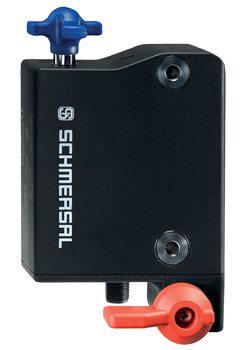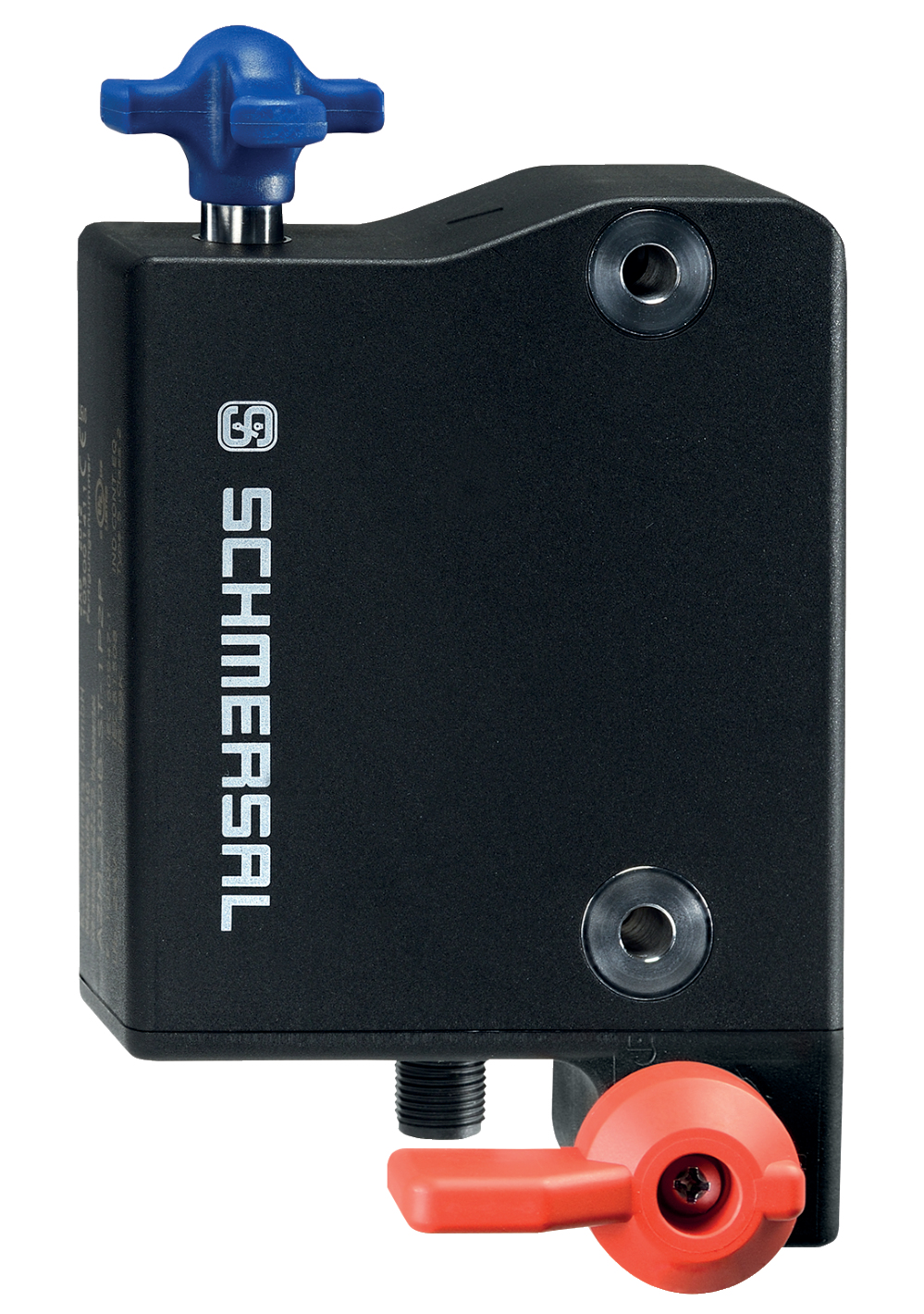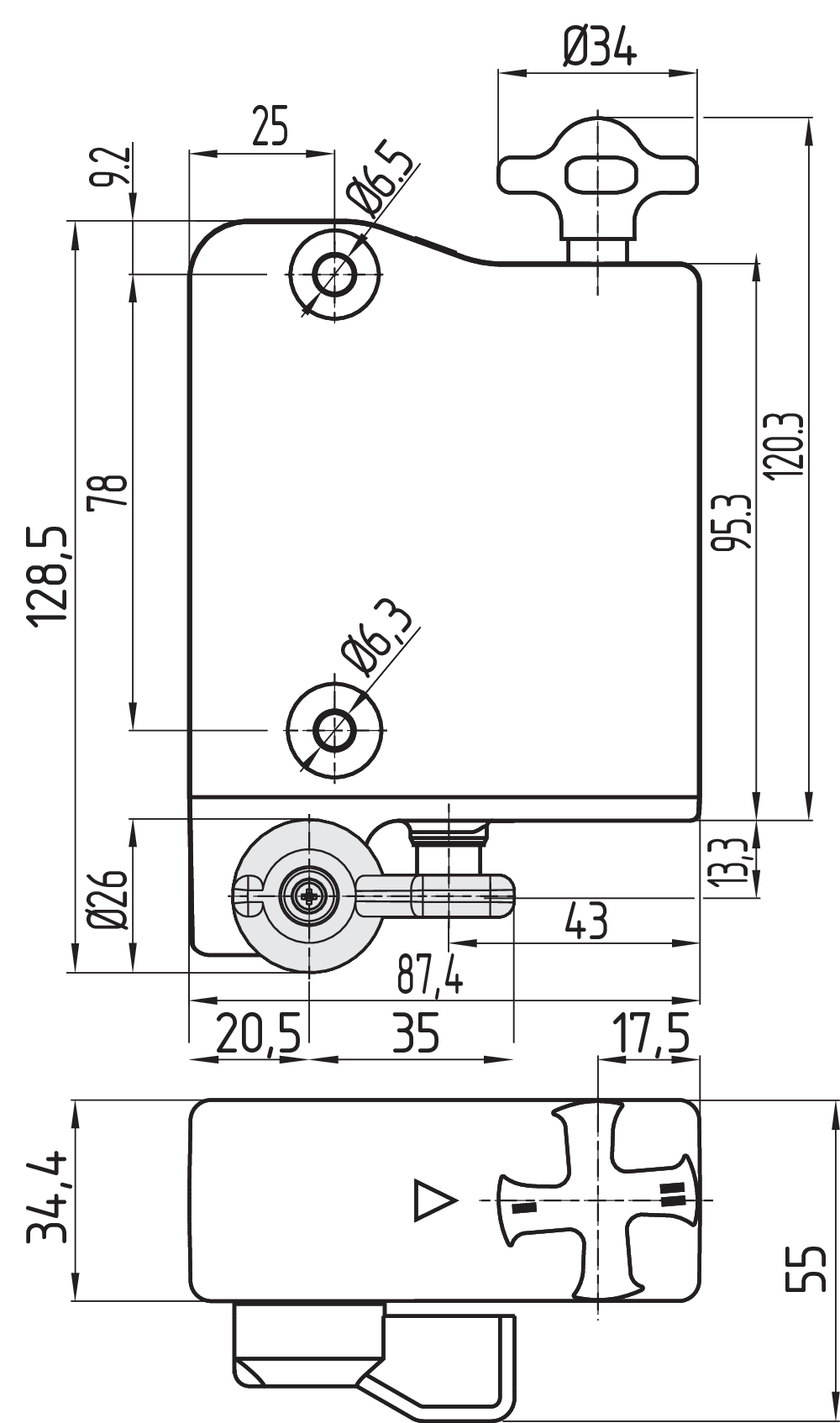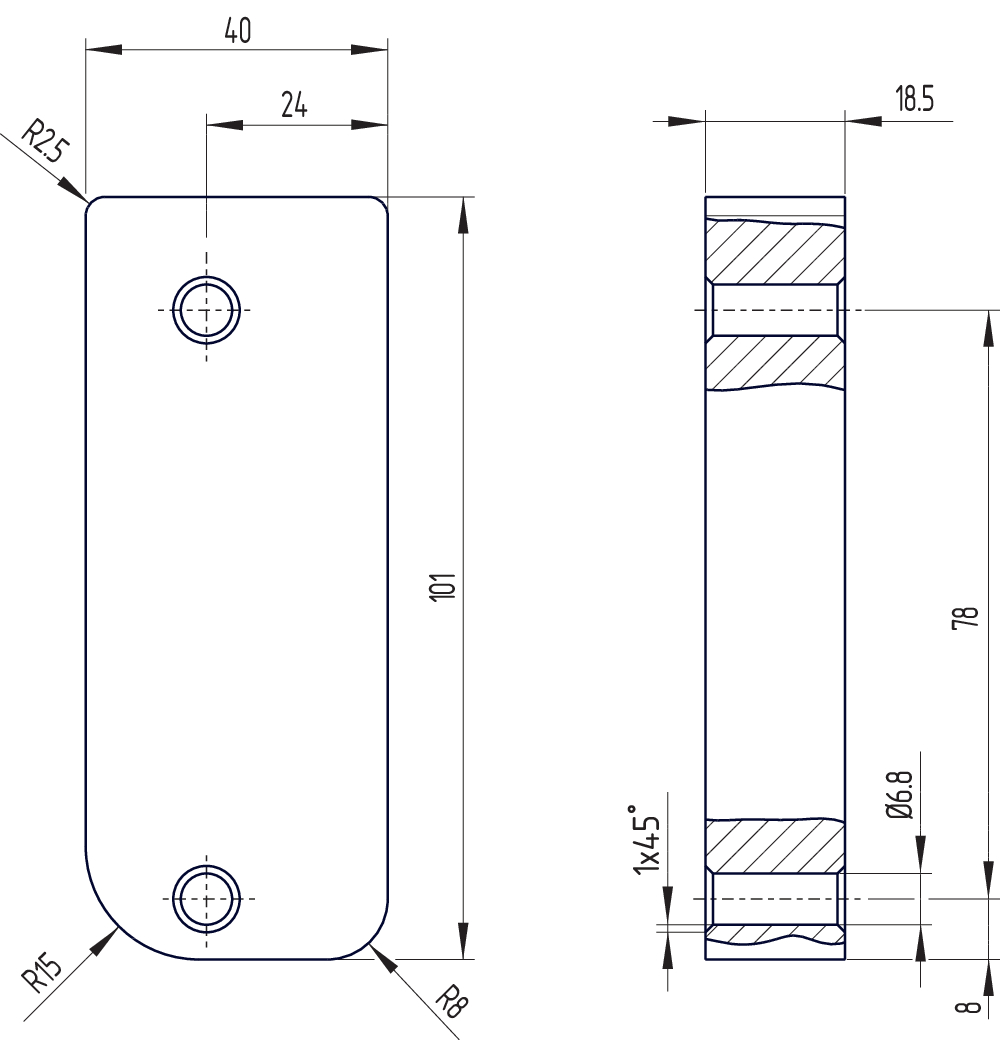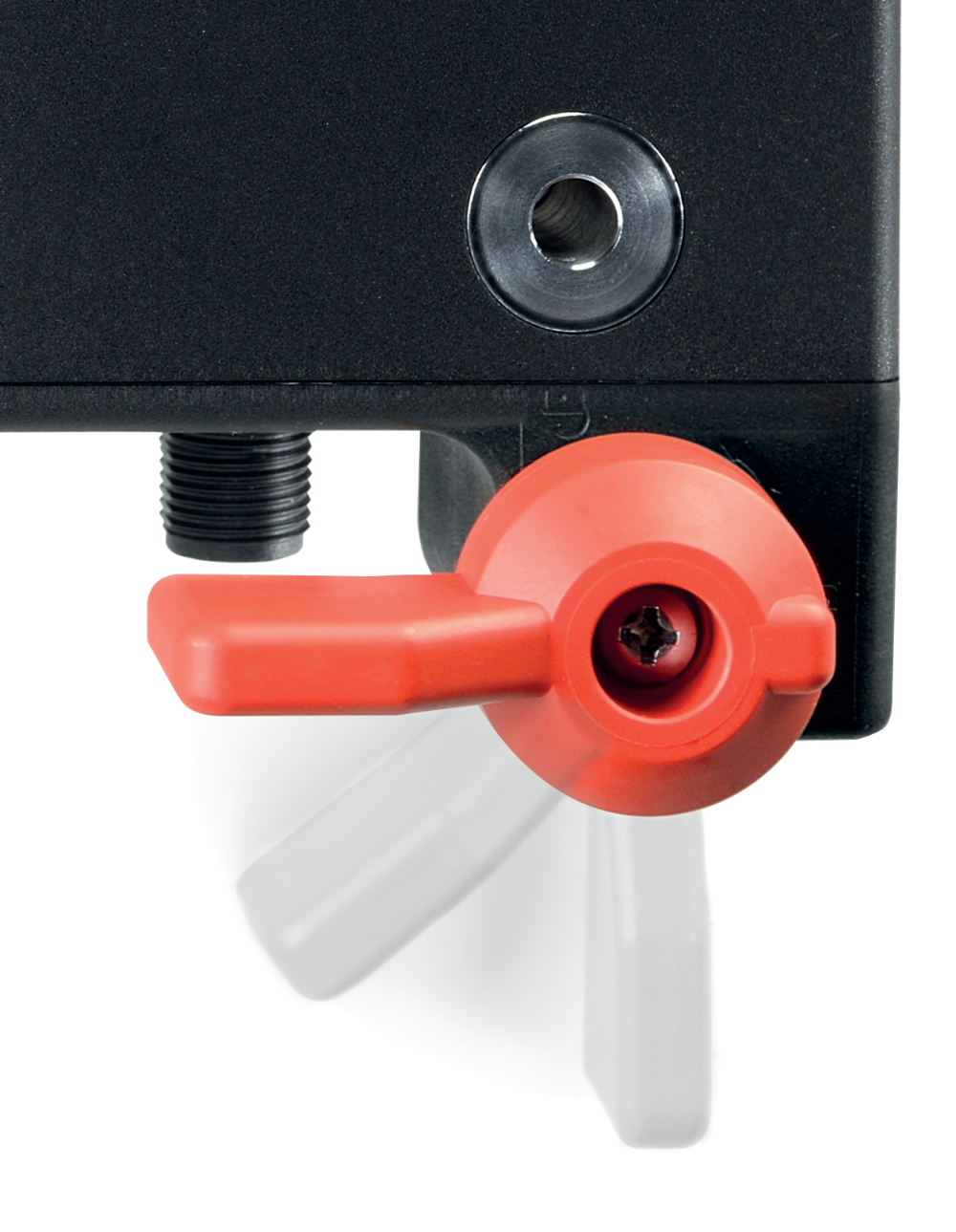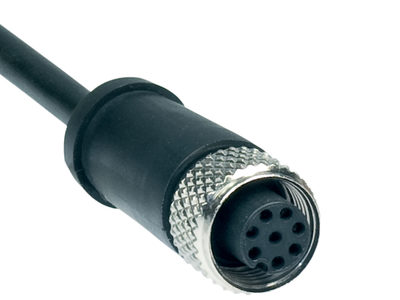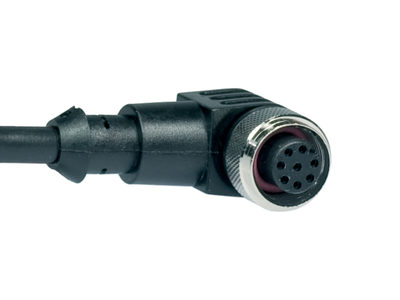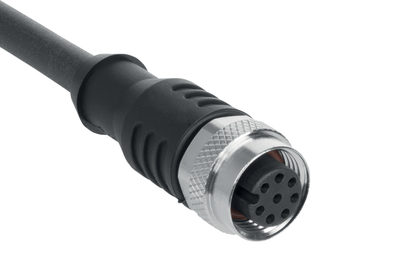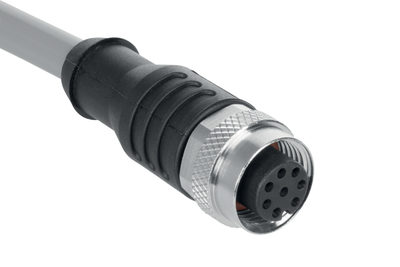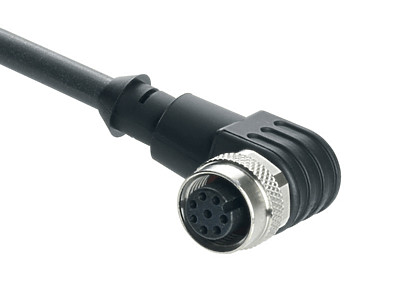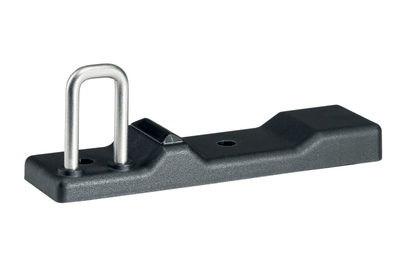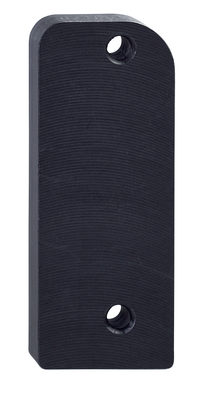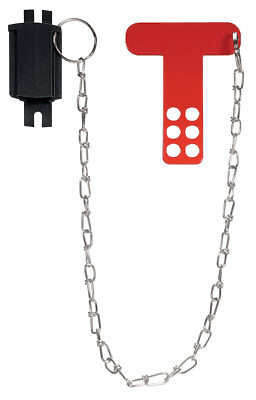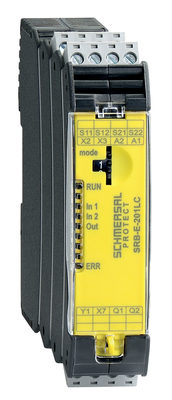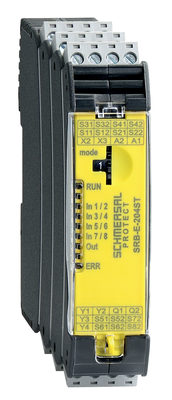AZM300B-ST-1P2P-T
AZM300B-ST-1P2P-T
| Codice: AZM300(1)-(2)-ST-(3)-(4)-(5) |
| (1) | |
| Z | Controllo ritenuta h |
| B | Controllo azionatore |
| (2) | |
| senza | Codifica standard |
| I1 | Codifica individuale |
| I2 | Codifica individuale, Teach-in ripetibile |
| (3) | |
| 1P2P | 1 uscita di diagnosi, a commutazione p e 2 uscite di sicurezza, a commutazione p |
| SD2P | Uscita di diagnosi seriale e 2 uscite di sicurezza, a commutazione p |
| (4) | |
| senza | Principio di corrente di riposo |
| A | Principio di corrente di lavoro |
| (5) | |
| senza | Sblocco manuale |
| N | Sblocco di emergenza |
| T | Sblocco di fuga |
| T 8 | Sblocco di fuga, distanza 8,5 mm |
- Codifica universale con tecnologia RFID
- collegamento ad innesto M12, 8 poli
- Principio di corrente di riposo
- Controllo azionatore
- Uscita di diagnosi
- Sblocco di fuga
- design igienico
- Grado di protezione IP69
- Adatto per applicazione su profili standard
- Custodia in plastica
- Protezione da manomissione con la tecnologia RFID in base alle necessità
- 3 diverse direzioni di azionamento
- Forma compatta
- 3 LEDs per l'indicazione delle condizioni d'esercizio
- Adatto per porte scorrevoli e ruotabili
- Azionamento in serie
- Sblocco manuale
Dati per l'ordine
| Codice |
AZM300B-ST-1P2P-T |
| Codice articolo (codice d'ordine) |
103006862 |
| EAN (European Article Number) |
4030661451060 |
| Numero eCl@ss, versione 12.0 |
27-27-26-03 |
| Numero eCl@ss, versione 11.0 |
27-27-26-03 |
| Numero eCl@ss, versione 9.0 |
27-27-26-03 |
| Numero ETIM, versione 7.0 |
EC002593 |
| Numero ETIM, versione 6.0 |
EC002593 |
Omologazioni - Prescrizioni
|
TÜV cULus ECOLAB FCC IC UKCA ANATEL |
Dati generali
| Prescrizioni |
EN ISO 13849-1 EN ISO 14119 EN IEC 60947-5-3 EN IEC 61508 |
|
| informazioni generali |
Codifica universale |
|
| Livello di codifica secondo EN ISO 14119 |
ridotta |
|
| principio d'azione |
RFID |
|
| Banda di frequenza RFID |
125 kHz |
|
| Potenza di trasmissione RFID, massimo |
-6 dBm |
|
| Materiale della custodia |
materiale sintetico, termoplastica rinforzata con fibra di vetro |
|
| Tempo di rischio, massimo |
200 ms |
|
|
100 ms |
|
|
1,5 ms |
|
| Peso lordo |
610 g |
Dati generali - Caratteristiche
| Principio di corrente di riposo |
Sì |
| Controllo azionatore |
Sì |
| Blocco |
Sì |
| Sblocco di fuga |
Sì |
| Riconoscimento cortocircuiti |
Sì |
| Riconoscimento di corto circuito |
Sì |
| Azionamento in serie |
Sì |
| Funzioni di sicurezza |
Sì |
| Display integrato, stato |
Sì |
| Numero direzioni di azionamento |
3 |
| Numero di uscite digitali sicure |
2 |
Osservazioni per la sicurezza
| Prescrizioni |
EN ISO 13849-1 EN IEC 61508 |
Osservazioni per la sicurezza - Funzione di ritenuta
| Performance Level, fino a |
e |
| Categoria di comando |
4 |
| Valore PFH |
5,20 x 10⁻¹⁰ /h |
| Valore PFD |
4,50 x 10⁻⁵ |
| Safety Integrity Level (SIL), idoneo per applicazioni in |
3 |
| Durata di utilizzo |
20 Anno(i) |
Dati meccanici
| Durata meccanica, minimo |
1.000.000 manovre |
| Osservazioni (durata meccanica) |
Se usato come fermaporta: ≥ 50.000 cicli di operazioni (massa della porta ≤ 5 kg e velocità di attuazione ≤ 0,5 m/s) |
| Spostamento angolare tra ritenuta e azionatore, massimo |
2 ° |
| Forza di mantenimento in chiusura secondo EN ISO 14119 |
1.150 N |
| Forza di mantenimento in chiusura, massima {N} |
1.500 N |
| Forza di chiusura, regolabile, posizione 1 |
25 N |
| Forza di chiusura, regolabile, posizione 2 |
50 N |
| Versione delle viti di fissaggio |
2x M6 |
| Coppia di serraggio per viti di fissaggio, minimum |
6 Nm |
| Coppia di serraggio delle viti di fissaggio, massima |
7 Nm |
Mechanical data - Switching distances
| Distanza di commutazione, tipico |
2 mm |
| Campo, distanza di commutazione sicura "ON" |
1 mm |
| Distanza di commutazione sicura "OFF" |
20 mm |
| Nota (distanza di commutazione) |
All switching distances in accordance EN IEC 60947-5-3 |
Dati meccanici - Tecnologia di collegamento
| Lunghezza della catena di sensori, massimo |
200 m |
| Osservazioni (Lunghezza della catena di sensori) |
Cable length and cross-section change the voltage drop dependiing on the output current |
| Osservazioni (Azionamento in serie) |
Unlimited number of devices, oberserve external line fusing, max. 31 devices in case of serial diagnostic SD |
| Connettore di collegamento |
Connettore M12, 8 poli, codifica A |
Dati meccanici - Dimensioni
| lunghezza del sensore |
146 mm |
| larghezza del sensore |
87,5 mm |
| altezza del sensore |
55 mm |
Condizioni ambientali
| Grado di protezione |
IP66 IP67 IP69 |
| Temperatura ambiente |
+0 ... +60 °C |
| Temperatura di stoccaggio e trasporto |
-10 ... +90 °C |
| Umidità relativa, massima |
93 % |
| Osservazioni (umidità relativa) |
non condensante non gela |
| Resistenza alle vibrazioni |
10 … 150 Hz, ampiezza 0,35 mm |
| resistenza a urti |
30 g / 11 ms |
| Classe di protezione |
III |
| Altitudine di installazione ammissibile s.l.m., massima |
3.000 m |
Condizioni ambientali - Valori di isolamento
| Tensione d'isolamento nominale |
32 VDC |
| Resistenza alla tensione impulsiva nominale |
0,8 kV |
| Categoria di sovratensione |
III |
| Grado di sporco |
3 |
Dati elettrici
| Tensione d'esercizio |
24 VDC -15 % / +10 % |
| Corrente a vuoto I0, tipica |
100 mA |
| Assorbimento di corrente con magnete ON, valore medio |
200 mA |
| Assorbimento di corrente con magnete ON, valore di picco |
350 mA / 200 ms |
| tensione d'esercizio nominale |
24 VDC |
| Corrente di funzionamento |
800 mA |
| Corrente di cortocircuito nominale richiesta |
100 A |
| Protezione esterna cavo e dispositivo |
2 A gG |
| Ritardo di disponibilità, massimo |
5.000 ms |
| Frequenza di commutaz, massimo |
0,5 Hz |
| Categoria d'utilizzo DC-12 |
24 VDC / 0,05 A |
| Protezione elettrica, massimo |
2 A |
Dati elettrici - Comando magnete IN
| Denominazione, Comando magnete |
IN |
| Soglie di commutazione |
-3 V … 5 V (Low) 15 V … 30 V (High) |
| Assorbimento di corrente a 24 V |
10 mA |
| Durata di azionamento magnete |
100 % |
| Durata dell'impulso di prova, massimo |
5 ms |
| Intervallo dell'impulso di prova, minimo |
40 ms |
| Classificazione ZVEI CB24I, Sink |
C0 |
| Classificazione ZVEI CB24I, Fonte |
C1 C2 C3 |
Dati elettrici - Ingressi digitali sicuri
| Denominazione, Ingressi di sicurezza |
X1 and X2 |
| Soglie di commutazione |
−3 V … 5 V (Low) 15 V … 30 V (High) |
| Assorbimento di corrente a 24 V |
5 mA |
| Durata dell'impulso di prova, massimo |
1 ms |
| Intervallo dell'impulso di prova, minimo |
100 ms |
| Classificazione ZVEI CB24I, Sink |
C1 |
| Classificazione ZVEI CB24I, Fonte |
C1 C2 C3 |
Dati elettrici - Uscite digitali sicure
| Denominazione, Uscite di sicurezza |
Y1 e Y2 |
| Versione |
resistente a cortocircuito, con commutazione p |
| Caduta di tensione Ud, massimo |
2 V |
| corrente residua |
0,5 mA |
| Tensione, Categoria d'utilizzo DC-12 |
24 VDC |
| Corrente, categoria d'utilizzo DC-12 |
0,25 A |
| Tensione, Categoria d'utilizzo DC-13 |
24 VDC |
| Corrente, categoria d'utilizzo DC-13 |
0,25 A |
| Intervallo dell'impulso di prova, tipicamente |
1000 ms |
| Durata dell'impulso di prova, massimo |
0,5 ms |
| Classificazione ZVEI CB24I, Fonte |
C2 |
| Classificazione ZVEI CB24I, Sink |
C1 C2 |
Dati elettrici - Uscita di diagnosi
| Designazione, Uscite diagnostiche |
OUT |
| Versione |
resistente a cortocircuito, con commutazione p |
| Caduta di tensione Ud, massimo |
2 V |
| Tensione, Categoria d'utilizzo DC-12 |
24 VDC |
| Corrente, categoria d'utilizzo DC-12 |
0,05 A |
| Tensione, Categoria d'utilizzo DC-13 |
24 VDC |
| Corrente, categoria d'utilizzo DC-13 |
0,05 A |
Segnalazione di stato
| Osservazioni (Indicatori di stato a LED) |
Stato operativo: LED giallo Errore malfunzionamento: LED rosso Tensione di alimentazione UB: LED verde |
Pin dei contatti
| Pin 1 |
A1 Tensione di alimentazione UB |
| Pin 2 |
X1 Entrata di sicurezza 1 |
| Pin 3 |
A2 GND |
| Pin 4 |
Y1 Uscita di sicurezza 1 |
| Pin 5 |
OUT Uscita di diagnosi |
| Pin 6 |
X2 Entrata di sicurezza 2 |
| Pin 7 |
Y2 Uscita di sicurezza 2 |
| Pin 8 |
IN Comando magnete |
Fornitura
| Fornitura |
Actuator must be ordered separately. |
Accessori
| Raccomandazione, (Azionatore) |
AZ/AZM300-B1 |
Osservazioni
| Nota (generale) |
Per porte che si chiudono a filo con il telaio della porta, è possibile utilizzare la piastra di montaggio opzionale MP-AZ/AZM300-1. Per porte in vetro o in MACROLON può essere utilizzata la piastra di montaggio opzionale MS-AZ/AZM300-B1-1. Il dispositivo di protezione sbloccato può essere nuovamente bloccato, a condizione che l'azionatore nell'elettroserratura rimanga inserito. In questo caso le uscite di sicurezza sono ri-abilitate, cosicchè il controllo di sicurezza non debba essere aperto. |
Filtro lingua
Scheda Tecnica
Manuale d'istruzioni e dichiarazione UE di conformità (breve)
Certificazione UL
Certificazione ECOLAB
FCC-Zertifikat
Certificato UKCA
Certificazione di collaudo
ANATEL certification
Brochure
Libreria SISTEMA-VDMA
Download dell'ultima versione di Adobe Reader
Immagine del prodotto (foto singola per catalogo)
Disegno quotato disp. di base
Disegno quotato (altro)
Schema poli
Esempio di azionamento
Dettaglio
Video ID: azm300-01
Video ID: azm300-06
Indice dei contenuti
- 1 Informazioni sul presente documento
- 1.1 Funzione
- 1.2 A chi è rivolto il Manuale d'istruzioni: personale specializzato autorizzato
- 1.3 Simbologia utilizzata
- 1.4 Uso conforme
- 1.5 Note generali di sicurezza
- 2 Descrizione del prodotto
- 2.1 Codice prodotto
- 2.2 Versioni speciali
- 2.3 Destinazione d'uso
- 2.4 Avvertenza in caso di uso non corretto
- 2.5 Liberatoria
- 2.6 Dati tecnici
- 3 Montaggio
- 3.1 Istruzioni di montaggio
- 3.2 Sblocco manuale
- 3.3 Sblocco di fuga -T/-T8 o Sblocco di emergenza -N
- 3.4 Montaggio con piastra di montaggio
- 3.5 Dimensioni
- 3.6 Azionatore e accessori
- 4 Collegamento elettrico
- 4.1 Note generali sul collegamento elettrico
- 4.2 Diagnosi seriale -SD
- 4.3 Per esempi di collegamenti in serie
- 4.4 Assegnazione dei collegamenti e connettori accessori
- 5 Codifica dell'azionatore e regolazione della forza di ritenuta
- 5.1 Codifica dell'azionatore
- 5.2 Regolazione della forza di ritenuta
- 6 Principio d'azione e Funzioni di diagnosi
- 6.1 Controllo del magnete
- 6.2 Uscite di sicurezza
- 6.3 LED di diagnosi
- 6.4 Elettroserratura di sicurezza con uscita di diagnosi convenzionale
- 6.5 Elettroserratura di sicurezza con funzione di diagnosi seriale SD
- 7 Messa in servizio e manutenzione
- 8 Smontaggio e smaltimento
- 8.1 Smontaggio
- 8.2 Smaltimento
1 Informazioni sul presente documento
1.1 Funzione
Il presente documento fornisce le informazioni richieste per il montaggio, la messa in servizio, il funzionamento sicuro e lo smontaggio del dispositivo di sicurezza. Conservare il manuale d'istruzioni allegato al dispositivo in condizioni leggibili e in un luogo facilmente accessibile.
1.2 A chi è rivolto il Manuale d'istruzioni: personale specializzato autorizzato
Le operazioni descritte nel Manuale d'istruzioni dovranno essere eseguite solo da personale specializzato qualificato e autorizzato dall'operatore dell'impianto.
Installare e utilizzare il dispositivo solo dopo avere letto e compreso il presente manuale d'istruzioni ed essendo a conoscenza delle disposizioni vigenti in materia di sicurezza sul lavoro e prevenzione degli infortuni.
La selezione e l'installazione dei dispositivi, così come i relativi collegamenti di controllo, richiedono una conoscenza approfondita delle normative di settore e dei requisiti di legge da parte del costruttore di macchine.
Il produttore non si assume alcuna responsabilità per quanto dichiarato. Si riserva il diritto di apportare modifiche tecniche migliorative.
1.3 Simbologia utilizzata
- Informazione, Suggerimento, Nota: Questo simbolo segnala utili informazioni aggiuntive.
- Attenzione: La mancata osservanza di questa nota di avvertenza può causare guasti o malfunzionamenti.
Avvertenza: La mancata osservanza di questa nota di avvertenza può causare danni personali e/o danni materiali alla macchina.
1.4 Uso conforme
La gamma di prodotti Schmersal non è destinata ai consumatori privati.
I prodotti qui descritti sono stati sviluppati come componenti d'impianto o di una macchina per lo svolgimento di funzioni di sicurezza. È responsabilità del produttore dell'impianto o della macchina garantire il corretto funzionamento generale.
Il dispositivo di sicurezza può essere installato solo conformemente alle seguenti applicazioni o per quelle autorizzate dal produttore. Per informazioni dettagliate sul campo d'impiego, vedere il capitolo “Descrizione del prodotto”.
1.5 Note generali di sicurezza
Osservare le note di sicurezza riportate nel manuale d'istruzioni, nonché le disposizioni nazionali relative ad installazione, sicurezza e prevenzione degli infortuni.
- Per ulteriori informazioni tecniche si rimanda ai cataloghi Schmersal o al catalogo online disponibile in Internet all'indirizzo products.schmersal.com.
2 Descrizione del prodotto
2.1 Codice prodotto
| Codice: AZM300(1)-(2)-ST-(3)-(4)-(5) |
| (1) | |
| Z | Controllo ritenuta h |
| B | Controllo azionatore |
| (2) | |
| senza | Codifica standard |
| I1 | Codifica individuale |
| I2 | Codifica individuale, Teach-in ripetibile |
| (3) | |
| 1P2P | 1 uscita di diagnosi, a commutazione p e 2 uscite di sicurezza, a commutazione p |
| SD2P | Uscita di diagnosi seriale e 2 uscite di sicurezza, a commutazione p |
| (4) | |
| senza | Principio di corrente di riposo |
| A | Principio di corrente di lavoro |
| (5) | |
| senza | Sblocco manuale |
| N | Sblocco di emergenza |
| T | Sblocco di fuga |
| T 8 | Sblocco di fuga, distanza 8,5 mm |
2.2 Versioni speciali
Per le versioni speciali con codice diverso da quanto elencato alla sezione Codice prodotto, le indicazioni riportate in precedenza e nel seguito si applicano solo nella misura in cui tali versioni sono conformi all'esecuzione di serie.
2.3 Destinazione d'uso
Il dispositivo di sicurezza elettronico senza contatto è idoneo per l'impiego in circuiti di sicurezza e serve per il controllo di posizione e il blocco di dispositivi di protezione mobili.
- I dispositivi di sicurezza sono classificati secondo EN ISO 14119 come dispositivi di blocco di tipo 4. Le versioni con codifica personalizzata sono classificati "a codifica alta".
Le diverse varianti del dispositivo possono essere utilizzate come interruttore di sicurezza con funzione di ritenuta oppure come elettroserratura di sicurezza.
- Qualora dall'analisi del rischio risulti necessaria una ritenuta con sorveglianza sicura, va applicata la variante con sorveglianza della ritenuta, contrassegnata nel codice prodotto dal simbolo >.
La variante sorvegliata dall'azionatore (B) è invece un interruttore di sicurezza con una funzione di ritenuta aggiuntiva per la protezione del processo.
La funzione di sicurezza consiste nella disattivazione sicura delle uscite di sicurezza allo sblocco o all'apertura del dispositivo di protezione e nel mantenimento sicuro di tale disattivazione con dispositivo di protezione aperto o sbloccato.
- Le elettroserrature con principio di corrente di lavoro possono essere utilizzate solo in casi specifici dopo un'approfondita valutazione del rischio di incidenti, poiché in caso di mancanza di tensione o di azionamento dell'interruttore principale il dispositivo di protezione può essere aperto immediatamente.
È possibile realizzare un azionamento in serie. In caso di collegamento in serie, il tempo di rischio rimane invariato e il tempo di reazione aumenta in misura pari alla somma dei tempi di reazione degli ingressi, riportati nei dati tecnici, per ciascun dispositivo aggiuntivo. Il numero dei dispositivi è limitato solo dalle perdite del cavo e dal fusibile di linea esterno, in base ai dati tecnici e alle perdite del cavo ammissibili. Nel caso di varianti con funzione di diagnosi seriale è possibile collegare in serie fino a 31 dispositivi.
- La valutazione e la progettazione della catena di sicurezza dovranno essere eseguite dall'utente nel rispetto delle norme e prescrizioni applicabili e in base al livello di sicurezza richiesto. Se alla stessa funzione di sicurezza sono collegati più sensori di sicurezza, è necessario sommare i valori PFH dei singoli componenti.
- Il progetto globale del controllo nel quale saranno integrati i componenti di sicurezza dovrà essere convalidato secondo le norme rilevanti.
2.4 Avvertenza in caso di uso non corretto
- L'eventuale utilizzo non corretto o non conforme o interventi non autorizzati possono causare pericoli per le persone o danni a componenti della macchina o dell'impianto in seguito all'impiego del dispositivo di sicurezza. Non sono noti altri rischi in caso di osservanza delle note sulla sicurezza e delle istruzioni di montaggio, messa in servizio, funzionamento e manutenzione.
2.5 Liberatoria
Il produttore non si assume alcuna responsabilità per danni e malfunzionamenti operativi dovuti ad errori di montaggio o alla mancata osservanza del presente manuale d'istruzioni. È esclusa inoltre ogni ulteriore responsabilità del produttore per danni risultanti dall'utilizzo di parti di ricambio o accessori non autorizzati dal produttore.
Per motivi di sicurezza non è permesso effettuare riparazioni, conversioni e modifiche arbitrarie e il produttore non si assume alcuna responsabilità per eventuali danni risultanti da tali operazioni.
2.6 Dati tecnici
Omologazioni - Prescrizioni
|
TÜV cULus ECOLAB FCC IC UKCA ANATEL |
Dati generali
| Prescrizioni |
EN ISO 13849-1 EN ISO 14119 EN IEC 60947-5-3 EN IEC 61508 |
|
| informazioni generali |
Codifica universale |
|
| Livello di codifica secondo EN ISO 14119 |
ridotta |
|
| principio d'azione |
RFID |
|
| Banda di frequenza RFID |
125 kHz |
|
| Potenza di trasmissione RFID, massimo |
-6 dBm |
|
| Materiale della custodia |
materiale sintetico, termoplastica rinforzata con fibra di vetro |
|
| Tempo di rischio, massimo |
200 ms |
|
|
100 ms |
|
|
1,5 ms |
|
| Peso lordo |
610 g |
Dati generali - Caratteristiche
| Principio di corrente di riposo |
Sì |
| Controllo azionatore |
Sì |
| Blocco |
Sì |
| Sblocco di fuga |
Sì |
| Riconoscimento cortocircuiti |
Sì |
| Riconoscimento di corto circuito |
Sì |
| Azionamento in serie |
Sì |
| Funzioni di sicurezza |
Sì |
| Display integrato, stato |
Sì |
| Numero direzioni di azionamento |
3 |
| Numero di uscite digitali sicure |
2 |
Osservazioni per la sicurezza
| Prescrizioni |
EN ISO 13849-1 EN IEC 61508 |
Osservazioni per la sicurezza - Funzione di ritenuta
| Performance Level, fino a |
e |
| Categoria di comando |
4 |
| Valore PFH |
5,20 x 10⁻¹⁰ /h |
| Valore PFD |
4,50 x 10⁻⁵ |
| Safety Integrity Level (SIL), idoneo per applicazioni in |
3 |
| Durata di utilizzo |
20 Anno(i) |
Dati meccanici
| Durata meccanica, minimo |
1.000.000 manovre |
| Osservazioni (durata meccanica) |
Se usato come fermaporta: ≥ 50.000 cicli di operazioni (massa della porta ≤ 5 kg e velocità di attuazione ≤ 0,5 m/s) |
| Spostamento angolare tra ritenuta e azionatore, massimo |
2 ° |
| Forza di mantenimento in chiusura secondo EN ISO 14119 |
1.150 N |
| Forza di mantenimento in chiusura, massima {N} |
1.500 N |
| Forza di chiusura, regolabile, posizione 1 |
25 N |
| Forza di chiusura, regolabile, posizione 2 |
50 N |
| Versione delle viti di fissaggio |
2x M6 |
| Coppia di serraggio per viti di fissaggio, minimum |
6 Nm |
| Coppia di serraggio delle viti di fissaggio, massima |
7 Nm |
Mechanical data - Switching distances
| Distanza di commutazione, tipico |
2 mm |
| Campo, distanza di commutazione sicura "ON" |
1 mm |
| Distanza di commutazione sicura "OFF" |
20 mm |
| Nota (distanza di commutazione) |
All switching distances in accordance EN IEC 60947-5-3 |
Dati meccanici - Tecnologia di collegamento
| Lunghezza della catena di sensori, massimo |
200 m |
| Osservazioni (Lunghezza della catena di sensori) |
Cable length and cross-section change the voltage drop dependiing on the output current |
| Osservazioni (Azionamento in serie) |
Unlimited number of devices, oberserve external line fusing, max. 31 devices in case of serial diagnostic SD |
| Connettore di collegamento |
Connettore M12, 8 poli, codifica A |
Dati meccanici - Dimensioni
| lunghezza del sensore |
146 mm |
| larghezza del sensore |
87,5 mm |
| altezza del sensore |
55 mm |
Condizioni ambientali
| Grado di protezione |
IP66 IP67 IP69 |
| Temperatura ambiente |
+0 ... +60 °C |
| Temperatura di stoccaggio e trasporto |
-10 ... +90 °C |
| Umidità relativa, massima |
93 % |
| Osservazioni (umidità relativa) |
non condensante non gela |
| Resistenza alle vibrazioni |
10 … 150 Hz, ampiezza 0,35 mm |
| resistenza a urti |
30 g / 11 ms |
| Classe di protezione |
III |
| Altitudine di installazione ammissibile s.l.m., massima |
3.000 m |
Condizioni ambientali - Valori di isolamento
| Tensione d'isolamento nominale |
32 VDC |
| Resistenza alla tensione impulsiva nominale |
0,8 kV |
| Categoria di sovratensione |
III |
| Grado di sporco |
3 |
Dati elettrici
| Tensione d'esercizio |
24 VDC -15 % / +10 % |
| Corrente a vuoto I0, tipica |
100 mA |
| Assorbimento di corrente con magnete ON, valore medio |
200 mA |
| Assorbimento di corrente con magnete ON, valore di picco |
350 mA / 200 ms |
| tensione d'esercizio nominale |
24 VDC |
| Corrente di funzionamento |
800 mA |
| Corrente di cortocircuito nominale richiesta |
100 A |
| Protezione esterna cavo e dispositivo |
2 A gG |
| Ritardo di disponibilità, massimo |
5.000 ms |
| Frequenza di commutaz, massimo |
0,5 Hz |
| Categoria d'utilizzo DC-12 |
24 VDC / 0,05 A |
| Protezione elettrica, massimo |
2 A |
Dati elettrici - Comando magnete IN
| Denominazione, Comando magnete |
IN |
| Soglie di commutazione |
-3 V … 5 V (Low) 15 V … 30 V (High) |
| Assorbimento di corrente a 24 V |
10 mA |
| Durata di azionamento magnete |
100 % |
| Durata dell'impulso di prova, massimo |
5 ms |
| Intervallo dell'impulso di prova, minimo |
40 ms |
| Classificazione ZVEI CB24I, Sink |
C0 |
| Classificazione ZVEI CB24I, Fonte |
C1 C2 C3 |
Dati elettrici - Ingressi digitali sicuri
| Denominazione, Ingressi di sicurezza |
X1 and X2 |
| Soglie di commutazione |
−3 V … 5 V (Low) 15 V … 30 V (High) |
| Assorbimento di corrente a 24 V |
5 mA |
| Durata dell'impulso di prova, massimo |
1 ms |
| Intervallo dell'impulso di prova, minimo |
100 ms |
| Classificazione ZVEI CB24I, Sink |
C1 |
| Classificazione ZVEI CB24I, Fonte |
C1 C2 C3 |
Dati elettrici - Uscite digitali sicure
| Denominazione, Uscite di sicurezza |
Y1 e Y2 |
| Versione |
resistente a cortocircuito, con commutazione p |
| Caduta di tensione Ud, massimo |
2 V |
| corrente residua |
0,5 mA |
| Tensione, Categoria d'utilizzo DC-12 |
24 VDC |
| Corrente, categoria d'utilizzo DC-12 |
0,25 A |
| Tensione, Categoria d'utilizzo DC-13 |
24 VDC |
| Corrente, categoria d'utilizzo DC-13 |
0,25 A |
| Intervallo dell'impulso di prova, tipicamente |
1000 ms |
| Durata dell'impulso di prova, massimo |
0,5 ms |
| Classificazione ZVEI CB24I, Fonte |
C2 |
| Classificazione ZVEI CB24I, Sink |
C1 C2 |
Dati elettrici - Uscita di diagnosi
| Designazione, Uscite diagnostiche |
OUT |
| Versione |
resistente a cortocircuito, con commutazione p |
| Caduta di tensione Ud, massimo |
2 V |
| Tensione, Categoria d'utilizzo DC-12 |
24 VDC |
| Corrente, categoria d'utilizzo DC-12 |
0,05 A |
| Tensione, Categoria d'utilizzo DC-13 |
24 VDC |
| Corrente, categoria d'utilizzo DC-13 |
0,05 A |
Segnalazione di stato
| Osservazioni (Indicatori di stato a LED) |
Stato operativo: LED giallo Errore malfunzionamento: LED rosso Tensione di alimentazione UB: LED verde |
Pin dei contatti
| Pin 1 |
A1 Tensione di alimentazione UB |
| Pin 2 |
X1 Entrata di sicurezza 1 |
| Pin 3 |
A2 GND |
| Pin 4 |
Y1 Uscita di sicurezza 1 |
| Pin 5 |
OUT Uscita di diagnosi |
| Pin 6 |
X2 Entrata di sicurezza 2 |
| Pin 7 |
Y2 Uscita di sicurezza 2 |
| Pin 8 |
IN Comando magnete |
Osservazioni sulla sicurezza
- La valutazione sulla sicurezza della funzione di ritenuta è valida solo per i dispositivi standard con funzione di ritenuta sorvegliata AZM300Z-…-1P2P-… (cfr. codice). Non è consentita una valutazione della sicurezza della funzione di ritenuta per dispositivi con diagnosi seriale "SD2P" a causa dei segnali di blocco/sblocco non sicuri tramite il gateway SD.
- Se in un'applicazione non è possibile utilizzare la versione con principio di corrente di riposo di un'elettroserratura di sicurezza, in questo caso eccezionale può essere impiegata una ritenuta con principio di corrente di lavoro, a condizione che si adottino misure di sicurezza aggiuntive capaci di garantire un analogo livello di sicurezza.
- La valutazione sulla sicurezza della funzione di ritenuta si riferisce al componente "ritenuta di sicurezza AZM" all'interno dell'impianto generale.
Ulteriori misure per l'esclusione dei guasti, quali un comando e un cablaggio sicuri, sono a carico del cliente.
In caso di guasto che provochi lo sblocco della funzione di ritenuta, tale condizione viene riconosciuta dall'elettroserratura di sicurezza e le uscite di sicurezza Y1/Y2 si disinseriscono in modo sicuro. La presenza di un guasto di questo tipo potrebbe causare la singola apertura immediata del dispositivo di protezione prima che la macchina abbia raggiunto lo stato sicuro. Il comportamento di un sistema di categoria 2 prevede che nell'intervallo fra i test, il verificarsi di un guasto determini la perdita della funzione di sicurezza e che la perdita di tale funzione di sicurezza sia rilevata dal test.
- Il comando dell'elettroserratura va tarato esternamente con l'abilitazione OSSD. Se si verifica un disinserimento per uno sblocco involontario, ciò viene rilevato dalla diagnostica esterna.
UL - Osservazioni
- Il presente dispositivo è predisposto per l'alimentazione da una sorgente conforme con limitazione di tensione, limitazione di corrente o di Classe 2. Il presente dispositivo deve essere alimentato tramite un modulo di connessione a connettore/cavo conforme (CYJV) con una corrente continua di almeno 24 V e 0,8 A.
FCC/IC - Osservazioni
Questo dispositivo è conforme alle disposizioni della Parte 15 delle normative FCC (Federal Communications Commission) USA e include trasmettitori/ricevitori che soddisfano i requisiti di esenzione dalla licenza secondo gli standard RSS di ISED (Innovation, Science and Economic Development) Canada.
Il funzionamento è soggetto alle due condizioni seguenti:
(1) il dispositivo non deve causare interferenze pericolose, e
(2) il dispositivo deve tollerare le interferenze ricevute, incluse le interferenze che possano causare un funzionamento indesiderato.
Il dispositivo è conforme ai limiti di esposizione per stimolazione nervosa (ISED SPR-002) per funzionamento con una distanza minima di 100 mm. Modifiche o adeguamenti non espressamente approvati da K.A. Schmersal GmbH & Co. KG possono far decadere il diritto dell'utente all'utilizzo del dispositivo.
Il trasmettitore/ricevitore esente da licenza incluso nel presente dispositivo è conforme ai requisiti per dispositivi radio esenti da licenza secondo la "Radio Standards Specification" (RSS) dell'ente canadese ISED (Innovation, Science and Economic Development). Il funzionamento è consentito a condizione che vengano soddisfatte entrambe le condizioni seguenti:
(1) Il dispositivo non deve emettere interferenze.
(2) Il dispositivo deve supportare eventuali interferenze radio ricevute, anche se tali interferenze ne potrebbero compromettere il funzionamento.
Questo dispositivo è conforme ai requisiti relativi ai limiti di esposizione per la stimolazione nervosa (ISED CNR-102) in processi con una distanza minima di 100 mm.
Modifiche o adeguamenti non espressamente approvati da K.A. Schmersal GmbH & Co. KG possono far decadere il diritto dell'utente all'utilizzo del dispositivo.
 20941-22-14519 | Este equipamento nao tem direito àprotecao contra interferência prejudicial e nao pode causar interferencia em sistemas devidamente autorizados. Para maiores informacores consultar: www.gov.br/anatel |
3 Montaggio
3.1 Istruzioni di montaggio
- Attenersi alle prescrizioni delle norme EN ISO 12100, EN ISO 14119 e EN ISO 14120.
Per il montaggio dell'elettroserratura di sicurezza e dell'azionatore sono predisposti per ciascuno due fori di fissaggio per viti M6 (coppia di serraggio: 6 … 7 Nm).
La posizione di utilizzo è liberamente selezionabile. Il funzionamento del sistema è consentito solo mantenendo un angolo tra ritenuta e azionatore di ≤ 2°.
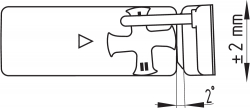
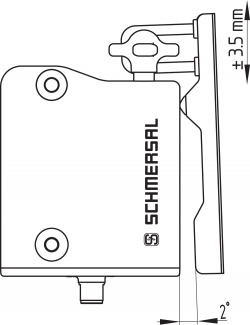
- L'elettroserratura di sicurezza può essere utilizzata come arresto. A seconda del peso della porta e della velocità di azionamento, ciò può comportare la riduzione della durata meccanica.
Montaggio degli azionatori
Vedere il manuale d'istruzioni dell'azionatore in uso.
- L'azionatore va fissato al dispositivo di protezione in modo irremovibile mediante misure idonee (ad es. utilizzo di viti autofilettanti, incollatura, alesatura delle teste delle viti, spine) e assicurato in modo da evitarne lo spostamento.
Direzioni di attuazione

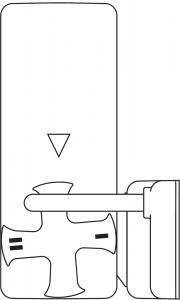

Le figure mostrano un dispositivo di protezione chiuso con una forza di ritenuta impostata di 50 N (vedi anche il capitolo "Regolazione della forza di ritenuta").
- Assicurare una presa sufficiente dell'azionatore nella croce girevole.
Corretto

Errato

Per evitare influenze dal sistema ed una riduzione delle distanze di commutazione, osservare le seguenti indicazioni:
- Parti metalliche nelle vicinanze del dispositivo di commutazione di sicurezza possono modificare la distanza di commutazione.
- Tenere lontano da residui di metallo.
Distanza minima tra due elettroserrature di sicurezza
o da altri sistemi con la stessa frequenza (125 kHz)
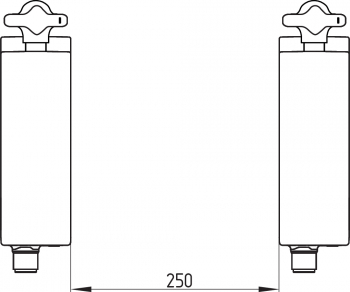
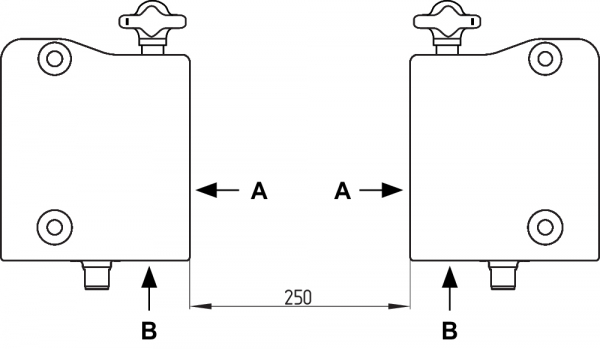
La distanza minima tra superfici di montaggio metalliche e il lato frontale "A" e il lato inferiore "B" del dispositivo è pari a 5 mm.


3.2 Sblocco manuale
Ai fini dell'installazione della macchina, l'elettroserratura di sicurezza può essere sbloccata in assenza di tensione. Girando lo sblocco manuale nella posizione q l'elettroserratura viene sbloccata. Solo riportando lo sblocco manuale nella posizione di partenza p si ripristina la normale funzione.
Attenzione: girando lo sblocco non superare il punto di arresto!
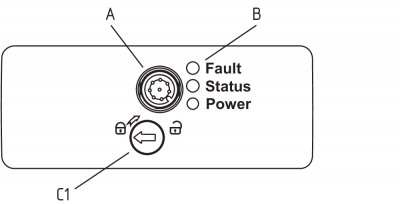

Legenda
A: Connettore maschio incorporato M12, 8 poli
B: LED di segnalazione
C1: Sblocco manuale con cacciavite a punta piatta
C2: Sblocco manuale con chiave triangolare TK-M5
Lo sblocco manuale deve essere protetto contro il l'azionamento involontario, ad es. utilizzando il sigillo fornito in dotazione dopo la messa in servizio.
3.3 Sblocco di fuga -T/-T8 o Sblocco di emergenza -N
Nelle varianti con sblocco di fuga e sblocco di emergenza, la leva rossa è libera e prima della messa in servizio deve essere montata sul triangolo dello sblocco, utilizzando l'apposita vite in dotazione, in modo che la freccia sul triangolo e il perno della leva rossa coincidano.
Il montaggio della leva è possibile su entrambi i lati. Il lato opposto può essere utilizzato come sblocco manuale mediante la chiave triangolare TK-M5.
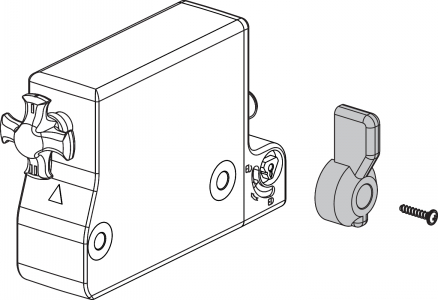
- L'utilizzatore dovrà escludere la possibilità di un ripristino dello sblocco manuale mediante l'azionamento della leva rossa di sblocco di fuga.
- Sblocco di fuga (-T/-T8)
Montaggio e attivazione solo all'interno della zona di pericolo.
Per lo sblocco di fuga, girare la leva rossa nella direzione indicata dalla freccia, fino all’arresto. Le uscite di sicurezza sono disattivate e il dispositivo di protezione può essere aperto. Per il rilascio della posizione di blocco, riportare la leva nella rispettiva posizione originale. Nella posizione sbloccata, il dispositivo di protezione è protetto da blocco involontario.
- Sblocco di emergenza (-N)
Montaggio e attivazione solo all'esterno della zona di pericolo. Lo sblocco di emergenza va utilizzato solo in caso di necessità. L'elettroserratura di sicurezza va applicata e/o protetta in modo che non sia possibile un'apertura involontaria della ritenuta mediante lo sblocco di emergenza. Lo sblocco di emergenza va contrassegnato in modo chiaro con l'avviso di uso per soli scopi di emergenza. A tale scopo è possibile utilizzare l'etichetta fornita.
Per lo sblocco d’emergenza, girare la leva rossa nella direzione indicata dalla freccia, fino all’arresto. Le uscite di sicurezza sono disattivate e il dispositivo di protezione può essere aperto. La leva è bloccata e non può essere riportata nella posizione originaria. Per terminare la posizione di blocco, la vite centrale di fissaggio, deve essere svitata fino a che la leva è riportata nella posizione originaria. La leva deve quindi essere fissata.
- Per poter assicurare una corretta funzione dello sblocco di fuga -T/-T8 e dello sblocco di emergenza -N, la porta di protezione non deve essere sottoposta a tensione meccanica.
- È possibile combinare uno sblocco di fuga e uno sblocco di emergenza. In questo caso, si prega di notare che quando la leva rossa viene azionata, anche la leva opposta ruota. Pertanto, per sbloccare la leva di sblocco di emergenza è necessario seguire la procedura sopra descritta.
3.4 Montaggio con piastra di montaggio
Per porte che si chiudono a filo con il telaio della porta, è possibile utilizzare la piastra di montaggio opzionale MP-AZ/AZM300-1.
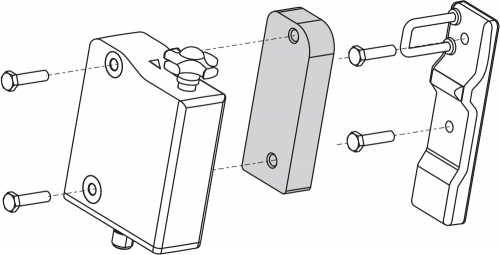

3.5 Dimensioni
Tutte le dimensioni sono in millimetri (mm).

AZM300...-T/-T8 o -N
Dispositivi con sblocco di fuga o di emergenza
Sblocco di fuga -T / Sblocco di emergenza -N
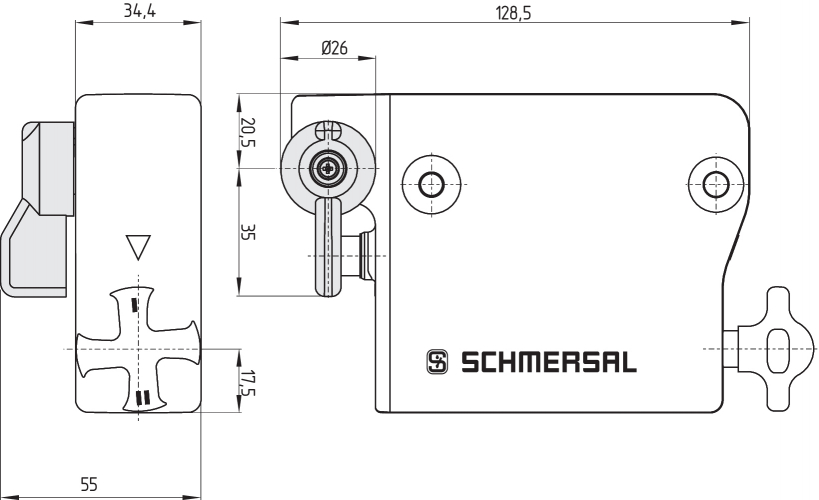
Sblocco di fuga -T8

3.6 Azionatore e accessori

Piastra di montaggio MP-AZ/AZM300-1 (disponibile come accessorio opzionale)
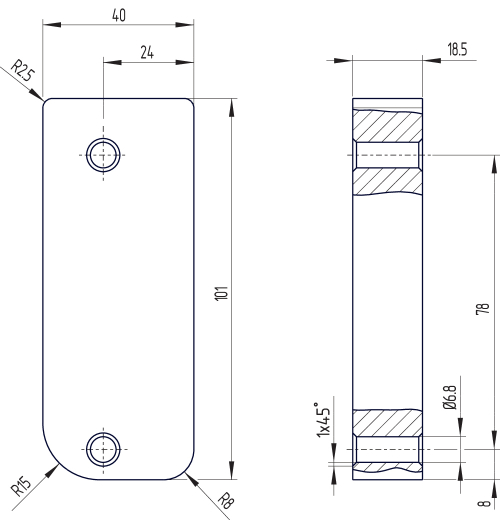
MS-AZ/AZM300-B1-1 (disponibile come accessorio opzionale)
Paraurti in alluminio come schermo per l'uso su porte di vetro e plastica su macchine con alti requisiti di design.
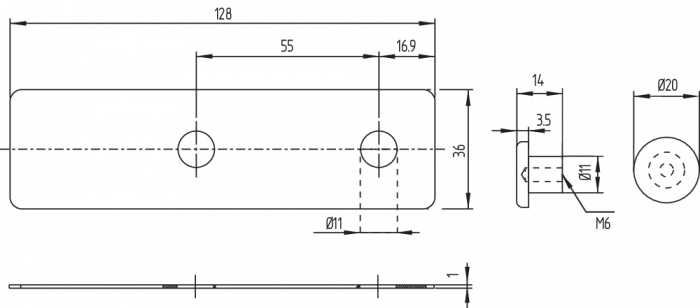
Pinza di bloccaggio SZ 200-1 (disponibile come accessorio opzionale)


Sblocco con tirante Bowden ACC-AZM300-BOW-.M-.M (disponibile come accessorio opzionale)
Osservare le note aggiuntive riportate nel manuale d'istruzioni per lo sblocco con tirante Bowden.
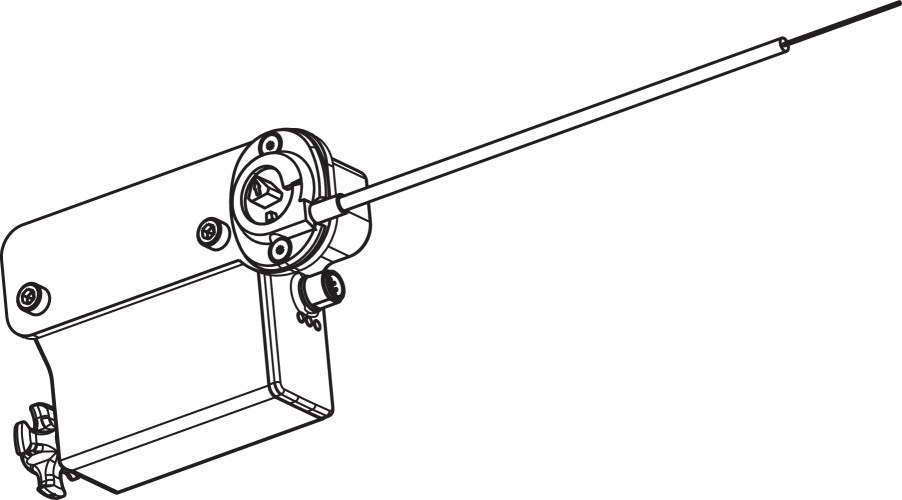
4 Collegamento elettrico
4.1 Note generali sul collegamento elettrico
- Il collegamento elettrico deve essere eseguito solo in condizioni di assenza di tensione e da personale specializzato autorizzato.
Gli ingressi in tensione A1, X1, X2 e IN devono essere protetti da sovratensione permanente. È pertanto necessario l'impiego di alimentatori PELV secondo la normativa EN 60204-1.
La protezione elettrica richiesta per il cavo va prevista durante l'installazione.
Le uscite di sicurezza possono essere utilizzate direttamente per il collegamento nel componente rilevante per la sicurezza dell'unità di controllo dell'utente.
Requisiti per il modulo di controllo/diagnosi collegato:
Ingresso di sicurezza a due canali, idoneo per 2 uscite a semiconduttore a commutazione p (positiva)
- Configurazione controllo di sicurezza
Se il sensore è collegato a moduli di controllo di sicurezza elettronici si raccomanda di impostare un tempo di discrepanza di almeno 100 ms. Gli ingressi di sicurezza del modulo di controllo devono essere in grado di escludere (blanking) un impulso di prova di ca. 1 ms. Non è invece richiesta la funzione di riconoscimento cortocircuito e, se presente, dovrà essere disattivata.
- Per ulteriori informazioni sulla selezione dei moduli di controllo di sicurezza idonei si rimanda ai cataloghi Schmersal o al catalogo online disponibile in Internet all'indirizzo products.schmersal.com.
4.2 Diagnosi seriale -SD
Layout del cablaggio
Il cavo collegato a una elettroserratura di sicurezza con funzione di diagnosi seriale non deve avere una capacità di linea superiore a 50 nF. I normali cavi di controllo non schermati LIYY da 0,25 mm² a 1,5 mm², a seconda della cordatura, presentano una capacità di linea di ca. 3 … 7 nF, per una lunghezza di 30 m.
- Nel cablaggio di dispositivi SD, prestare attenzione alla caduta di tensione sui cavi e alla capacità di carico di corrente dei singoli componenti.
- Accessori per azionamento in serie
Per un facile cablaggio e collegamento in serie di dispositivi SD sono disponibili i box di collegamento PFB-SD-4M12-SD (variante per il livello di campo) e PDM-SD-4CC-SD (variante per quadro elettrico, installabile su guida DIN), nonché svariati altri accessori. Per informazioni dettagliate, visitare il sito Internet products.schmersal.com.
4.3 Per esempi di collegamenti in serie
È possibile realizzare un azionamento in serie. In caso di collegamento in serie, il tempo di rischio rimane invariato e il tempo di reazione aumenta in misura pari alla somma dei tempi di reazione degli ingressi, riportati nei dati tecnici, per ciascun dispositivo aggiuntivo. Il numero dei dispositivi è limitato solo dalle perdite del cavo e dal fusibile di linea esterno, in base ai dati tecnici e alle perdite del cavo ammissibili. Nel caso di dispositivi AZM300 … SD con funzione di diagnosi seriale è possibile collegare in serie fino a 31 unità.
Gli esempi applicativi qui rappresentati sono proposte che non esonerano l'utente dal controllare accuratamente l'idoneità del collegamento alla specifica applicazione.
Esempio di collegamento 1: Collegamento in serie di AZM300 con uscita di diagnosi convenzionale
La tensione viene alimentata sull'ultimo dispositovo di sicurezza della catena (visto dalla prospettiva del sistema di controllo a valle) ad entrambi gli ingressi di sicurezza. Le uscite di sicurezza del primo dispositivo di sicurezza sono indirizzate al modulo di controllo.
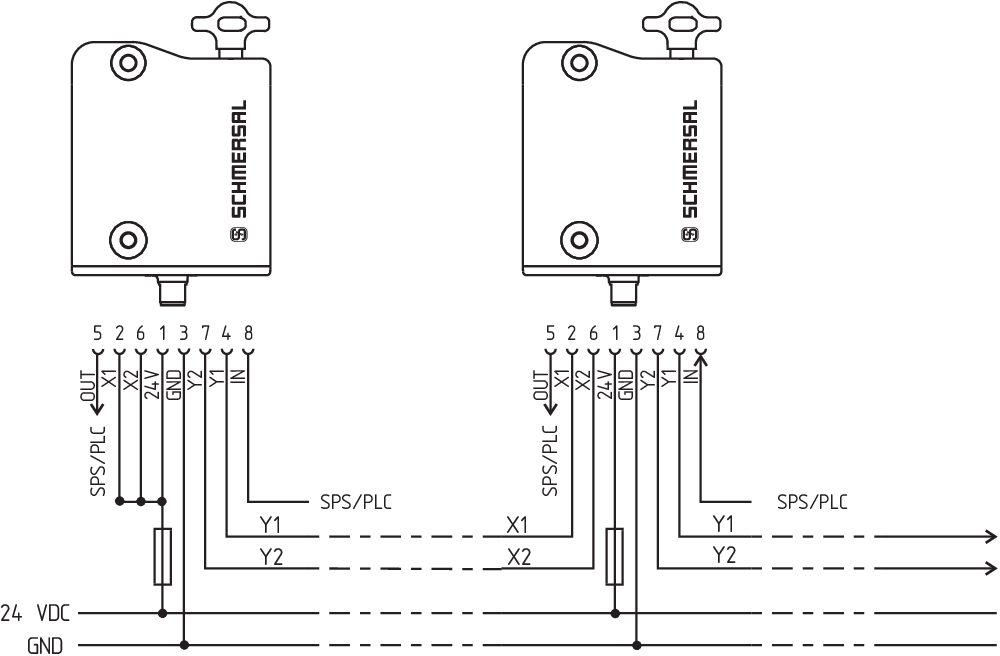
Y1 e Y2 = uscite di sicurezza -> modulo di controllo
Esempio di collegamento 2: Collegamento in serie di AZM300 con funzione di diagnosi seriale (max. 31 dispositivi in serie)
Nei dispositivi con funzione di diagnosi seriale (indice d'ordine -SD), i collegamenti di diagnosi seriale sono commutati in serie e indirizzati per l'analisi a un gateway SD. Le uscite di sicurezza del primo dispositivo di sicurezza sono indirizzate al modulo di controllo. Il gateway di diagnosi seriale è collegato all'ingresso di diagnosi seriale del primo dispositivo di sicurezza.

Y1 e Y2 = uscite di sicurezza -> modulo di controllo
SD-IN → Gateway → Bus di campo
4.4 Assegnazione dei collegamenti e connettori accessori
| Funzione dispositivo di sicurezza | Assegnazione pin del connettore | Codifica dei colori per connettori Schmersal | Possibile codifica dei colori di altri connettori in commercio Codifica dei colori di altri connettori disponibili in commercio secondo EN 60947-5-2 | |||
|---|---|---|---|---|---|---|
| con uscita di diagnosi convenzionale | con Funzione diagnostica seriale |  | IP67 / IP69 secondo DIN 47100 | IP69 (PVC) | ||
| A1 | Ue | 1 | WH | BN | BN | |
| X1 | Ingresso di sicurezza 1 | 2 | BN | WH | WH | |
| A2 | GND | 3 | GN | BU | BU | |
| Y1 | Uscita di sicurezza 1 | 4 | YE | BK | BK | |
| OUT | Uscita di diagnosi | Uscita SD | 5 | GY | GY | GY |
| X2 | Ingresso di sicurezza 2 | 6 | PK | VT | PK | |
| Y2 | Uscita di sicurezza 2 | 7 | BU | RD | VT | |
| IN | Comando magnete | Ingresso SD | 8 | RD | PK | OR |
Assegnazione dei collegamenti diversa quando si utilizza il distributore a Y CSS-Y-8P per il collegamento al gateway SD.
| Segnale | Pin | Connettore (2) | Colori dei conduttori | |||
|---|---|---|---|---|---|---|
| Cavo SCHMERSAL | Cavo secondo EN 60947-5-2 | Cavo secondo DIN 47100 | ||||
| A1 | 1 | Ue | BN | BN | WH |  |
| A1 | 2 | Ue | WH | WH | BN | |
| A2 | 3 | GND | BU | BU | GN | |
| A2 | 4 | GND | BK | BK | YE | |
| Y1 | 5 | Uscita di sicurezza 1 | GY | GY | GY | |
| Y2 | 6 | Uscita di sicurezza 2 | VT | PK | PK | |
| IN | 7 | Ingresso SD | RD | VT | BU | |
| OUT | 8 | Uscita SD | PK | OR | RD | |
| Cavi di collegamento (PUR) con connettore femmina IP67 / IP69, M12, 8 poli - 8 x 0,25 mm² secondo DIN 47100 | |
|---|---|
| Lunghezza cavo | Codice articolo |
| 2,5 m | 103011415 |
| 5,0 m | 103007358 |
| 10,0 m | 103007359 |
| 15,0 m | 103011414 |
| Cavi di collegamento (PVC) con connettore femmina M12, 8 poli - 8 x 0,21 mm², IP69 | |
|---|---|
| Lunghezza cavo | Codice articolo |
| 5,0 m | 101210560 |
| 5,0 m, angolare | 101210561 |
| 10,0 m | 103001389 |
| 15,0 m | 103014823 |
5 Codifica dell'azionatore e regolazione della forza di ritenuta
5.1 Codifica dell'azionatore
Le elettroserrature di sicurezza con codifica standard sono pronte per il funzionamento alla consegna.
Procedura per il reciproco rilevamento di elettroserrature di sicurezza e azionatori con codifica personalizzata:
- Spegnere e riaccendere l'elettroserratura di sicurezza.
- Portare l'azionatore nell'area di acquisizione. La procedura di rilevamento viene segnalata nell'elettroserratura di sicurezza con LED verde spento, LED rosso acceso e LED giallo lampeggiante (1 Hz).
- Dopo 10 secondi, brevi impulsi lampeggianti (3 Hz) indicano la necessità di disattivare la tensione d'esercizio dell'elettroserratura di sicurezza. Se entro 5 minuti non avviene alcuna disinserzione, l'elettroserratura di sicurezza interrompere la procedura di rilevamento e segnala un azionatore non corretto mediante lampeggiamento rosso per 5 volte.
- Alla successiva inserzione della tensione d'esercizio l'azionatore dovrà essere nuovamente rilevato per attivare il codice acquisito dell'azionatore. Il codice attivato viene quindi salvato permanentemente.
Nell'opzione d'ordine -I1, l'assegnazione così effettuata di dispositivo di sicurezza e azionatore è irreversibile.
Nell'opzione d'ordine -I2 la procedura di acquisizione di un nuovo azionatore può essere ripetuta un numero illimitato di volte. Con l'acquisizione di un nuovo azionatore il precedente codice non è più valido. Inoltre un blocco di abilitazione di dieci minuti assicura una maggiore protezione da manomissione. Il LED verde lampeggia finché non è trascorso l'intervallo di blocco abilitazione ed il nuovo azionatore è stato acquisito. In caso di interruzione dell'alimentazione durante questo intervallo, il tempo di protezione antimanomissione di 10 minuti ricomincia da capo.
5.2 Regolazione della forza di ritenuta
Per un funzionamento corretto del dispositivo è necessario che la croce girevole si trovi in posizione I o II con dispositivo di protezione aperto. Nella posizione intermedia il blocco non è possibile. La forza di ritenuta può essere facilmente modificata ruotando di 180° la croce girevole.
In posizione I la forza di ritenuta è pari a ca. 25 N.
In posizione II la forza di ritenuta è pari a ca. 50 N.

6 Principio d'azione e Funzioni di diagnosi
6.1 Controllo del magnete
Nella variante a corrente di riposo dell'elettroserratura di sicurezza AZM300, l'impostazione in normali condizioni d'esercizio del segnale IN (= 24 V) determina lo sblocco della ritenuta. Nella variante a corrente di lavoro dell'AZM300 in caso di impostazione del segnale IN (= 24 V) in esercizio la ritenuta è invece bloccata.
6.2 Uscite di sicurezza
Nella versione AZM 300 Z, lo sblocco dell'elettroserratura di sicurezza determina la disattivazione delle uscite di sicurezza. Il dispositivo di protezione sbloccato può essere nuovamente bloccato, a condizione che l'azionatore si trovi sull'elettroserratura AZM300Z; le uscite di sicurezza verranno quindi nuovamente attivate.
Non è richiesta l'apertura del dispositivo di protezione.
Nella variante AZM300B l'apertura del dispositivo di protezione determina la disattivazione delle uscite di sicurezza.
6.3 LED di diagnosi
L'elettroserratura di sicurezza segnala lo stato operativo, nonché gli eventuali errori e malfunzionamenti, mediante tre LED di colore diverso presenti.
| verde (Power) | tensione di alimentazione presente |
| giallo (Stato) | Condizioni d'esercizio |
| rosso (Fault) | Errore (v. Tabella 2: Segnalazioni di errore / Codici di lampeggiamento LED di diagnosi rosso) |
| Stato del sistema Nessun segnale di ingresso su X1 e/o X2 | LED | ||
|---|---|---|---|
| verde | rosso | giallo | |
| Porta aperta e una porta collegata in serie a monte è anch'essa aperta | lampeggia (1 Hz) | spento | spento |
| Porta chiusa e una porta collegata in serie a monte è aperta | lampeggia (1 Hz) | spento | lampeggia |
| Porta bloccata e una porta collegata in serie a monte è aperta | lampeggia (1 Hz) | spento | acceso |
6.4 Elettroserratura di sicurezza con uscita di diagnosi convenzionale
L'uscita diagnostica OUT a prova di cortocircuito può essere usata per la visualizzazione centrale o per task di controllo, ad es. in un PLC.
L'uscita di diagnosi non è un'uscita rilevante per la sicurezza!
Errore
Eventuali errori che compromettono il funzionamento sicuro del dispositivo di sicurezza (errori interni) determinano la disattivazione delle uscite di sicurezza nel tempo di rischio. Dopo la risoluzione dell'errore, il messaggio di errore viene resettato mediante apertura e richiusura della porta di sicurezza corrispondente.
Avvertenza di errore
Un errore che non compromette immediatamente il funzionamento sicuro del dispositivo di sicurezza (ad es. temperatura ambiente troppo elevata, uscita di sicurezza su potenziale esterno, cortocircuito trasversale) determina una disattivazione ritardata (vedi Tabella 2). Questa combinazione di segnali con "uscita di diagnosi disattivata" e "uscite di sicurezza ancora attive" può essere utilizzata per fermare la macchina in modo preordinato.
L'avvertenza viene resettata quando la causa dell'errore è stata rimossa.
Se l'avvertenza di errore rimane attiva per 30 minuti, vengono disattivate anche le uscite di sicurezza (il LED rosso lampeggia, vedi Tabella 2).
Comportamento dell'uscita di diagnosi - esempio con ritenuta che opera secondo il principio della corrente di riposo
Segnale di ingresso controllo magnete

Funzionamento normale, porta bloccata

Impossibile bloccare la porta o errore

 | Porta aperta |  | Porta chiusa |  | Tempo di blocco |
 | Porta non bloccata o errore |  | Porta bloccata | ||
 | Blocco |  | Sblocco |
Valutazione dell'uscita di diagnosi della

Corrente di riposo: IN = 0 = blocco
 | La porta può essere bloccata |
 | La porta è bloccata |
Corrente di lavoro: IN = 1 = blocco
 | La porta può essere bloccata |
 | La porta è bloccata |
| Tabella 1: Informazioni di diagnosi del dispositivo di sicurezza | ||||||||
|---|---|---|---|---|---|---|---|---|
| Stato del sistema | Controllo magnete IN | LED | Uscite di sicurezza Y1, Y2 | Uscita di diagnosi OUT | ||||
| Corrente di riposo | Corrente di lavoro | verde | rosso | giallo | AZM300Z | AZM300B | ||
| porta aperta | 24 V (0 V) | 0 V (24 V) | acceso | spento | spento | 0 V | 0 V | 0 V |
| Porta chiusa, non bloccata | 24 V | 0 V | acceso | spento | lampeggia | 0 V | 24 V | 24 V |
| Porta chiusa, blocco non possibile | 0 V | 24 V | acceso | spento | lampeggia | 0 V | 24 V | 0 V |
| Porta chiusa, e bloccato | 0 V | 24 V | acceso | spento | acceso | 24 V | 24 V | 24 V |
| Avvertenza di errore1) | 0 V | 24 V | acceso | lampeggia2) | acceso | 24 V1) | 24 V1) | 0 V |
| Errore | 0 V (24 V) | 24 V (0 V) | acceso | lampeggia2) | spento | 0 V | 0 V | 0 V |
| Nessun segnale di ingresso su X1 e/o X2 | 0 V (24 V) | 24 V (0 V) | lampeggia | spento | spento | 0 V | 0 V | 0 V |
| Nessun segnale di ingresso su X1 e/o X2 | 0 V (24 V) | 24 V (0 V) | lampeggia | spento | acceso/ lampeggia | 0 V | 0 V | 24 V |
| Inoltre per versione I1/I2: | ||||||||
| Acquisizione azionatore avviata | spento | acceso | lampeggia | 0 V | 0 V | 0 V | ||
| Solo I2: procedura acquisizione azionatore (blocco abilitazione) | lampeggia | spento | spento | 0 V | 0 V | 0 V | ||
1) dopo 30 min: disinserzione per errore 2) v. codice intermittente | ||||||||
| Tabella 2: Segnalazioni di errore / Codici di lampeggiamento LED di diagnosi rosso | |||
|---|---|---|---|
| Codici intermittenti (rosso) | Denominaz. | Disattivazione automatica dopo | Causa dell'errore |
| 1 impulso intermittente | Errore/avvertenza all'uscita Y1 | 30 min | Errore nel test dell'uscita o tensione all'uscita Y1, nonostante l'uscita sia disattivata |
| 2 impulsi intermittenti | Errore/avvertenza all'uscita Y2 | 30 min | Errore nel test dell'uscita o tensione all'uscita Y2, nonostante l'uscita sia disattivata |
| 3 impulsi intermittenti | Errore/avvertenza cortocircuito | 30 min | Cortocircuito tra i cavi di uscita o errore su entrambe le uscite |
| 4 impulsi intermittenti | Errore/avvertenza sovratemperatura | 30 min | La misurazione della temperatura riporta una temperatura interna troppo elevata |
| 5 impulsi intermittenti | Errore azionatore | 0 min | Azionatore non valido o difettoso, rottura archetto, Disturbi del segnale RFID |
| 6 impulsi intermittenti | Errore croce girevole | 0 min | Croce girevole in posizione intermedia non consentita |
| Rosso continuo | Errore interno | 0 min | Malfunzionamento dispositivo |
6.5 Elettroserratura di sicurezza con funzione di diagnosi seriale SD
Le elettroserrature di sicurezza con funzione di diagnosi seriale sono dotate, invece che dell'uscita di diagnosi convenzionale, di un cavo di ingresso e uscita seriale. In caso di azionamento in serie delle elettroserrature di sicurezza, i dati di diagnosi vengono trasmessi attraverso il collegamento in serie di questi cavi di ingresso e uscita.
È possibile collegare in serie fino a 31 elettroserrature di sicurezza. Per la sorveglianza del cavo di diagnosi seriale si utilizza il gateway PROFIBUS SD-I-DP-V0-2 o il gateway universale SD-I-U-…. Questa interfaccia di diagnosi seriale viene collegata come slave ad un sistema bus di campo disponibile. I segnali di diagnosi possono così essere analizzati con un PLC.
Il software necessario per il collegamento dei gateway SD è disponibile in Internet all'indirizzo products.schmersal.com.
I dati di risposta e i dati di diagnosi per ciascuna elettroserratura di sicurezza collegata in serie vengono scritti in modo automatico e continuo in un byte di ingresso del PLC. I dati di richiesta per ciascuna elettroserratura di sicurezza sono trasmessi invece attraverso un byte di uscita del PLC al dispositivo. Se si verifica un errore di comunicazione tra il gateway SD e l'elettroserratura di sicurezza, quest'ultima mantiene il proprio stato di commutazione.
Errore
Eventuali errori che compromettono il funzionamento sicuro del dispositivo di sicurezza (errori interni) determinano la disattivazione delle uscite di sicurezza nel tempo di rischio. L'errore viene resettato quando la relativa causa è stata rimossa e il bit 7 del byte di richiesta passa da 1 a 0 o la porta viene aperta. Eventuali errori alle uscite di sicurezza saranno resettati solo alla successiva abilitazione, perché la risoluzione dell'errore non può essere rilevata prima.
Avvertenza di errore
Un errore che non compromette immediatamente il funzionamento sicuro del dispositivo di sicurezza (ad es. temperatura ambiente troppo elevata, uscita di sicurezza su potenziale esterno, cortocircuito trasversale) determina una disattivazione ritardata (vedi Tabella 2). Questa combinazione di segnali con "uscita di diagnosi disattivata" e "uscite di sicurezza ancora attive" può essere utilizzata per fermare la macchina in modo preordinato.
L'avvertenza viene resettata quando la causa dell'errore è stata rimossa.
Se l'avvertenza di errore rimane attiva per 30 minuti, vengono disattivate anche le uscite di sicurezza (il LED rosso lampeggia, vedi Tabella 2).
Errore/avvertenza di diagnosi
Se nel byte di risposta viene segnalato un errore/un'avvertenza, è possibile leggere informazioni dettagliate sull'errore.
| Tabella 3: Dati I/O e dati di diagnosi (Stato descritto raggiunto, quando Bit = 1) | ||||
|---|---|---|---|---|
| N. bit | Byte di richiesta | Byte di risposta | Diagnosi avvertenza | Diagnosi errore |
| Bit 0 | Magnete ON, indipendentemente dal principio di corrente di lavoro o di riposo | Uscita di sicurezza attivata | Errore all'uscita Y1 | Errore all'uscita Y1 |
| Bit 1 | --- | Dispositivo di protezione chiuso E blocco/sblocco possibile 1) | Errore all'uscita Y2 | Errore all'uscita Y2 |
| Bit 2 | --- | Azionatore riconosciuto e bloccato | Cortocircuito | Cortocircuito |
| Bit 3 | --- | --- | Sovratemperatura | Sovratemperatura |
| Bit 4 | --- | Stato ingresso X1 e X2 | --- | Azionatore non valido o difettoso, rottura archetto, Disturbi del segnale RFID |
| Bit 5 | --- | Azionatore valido rilevato | Errore interno del dispositivo | Errore interno del dispositivo |
| Bit 6 | --- | Avvertenza di errore 2) | Errore di comunicazione tra gateway bus di campo e dispositivo di commutazione di sicurezza | --- |
| Bit 7 | Reset errore | Errore (circuito di abilitazione disattivato) | Croce girevole in posizione intermedia non consentita | Croce girevole in posizione intermedia non consentita |
| 1) Questo messaggio di diagnostica tramite il bit 1 segnala se è possibile o meno bloccare o sbloccare il dispositivo di protezione. L'ettroserratura di sicurezza non può essere sbloccata, ad esempio, quando la porta fa fuoriuscire la croce girevole dalla sua posizione di riposo tramite la forza di ritenuta impostata. Ciò può verificarsi in caso di porte sottoposte a una tensione elevata o quando si esercita una forza di trazione sulla porta. L'ettroserratura di sicurezza può essere bloccato solo quando la croce girevole si trova nella posizione di riposo, cioè quando la forza di ritenuta è sufficiente a trattenere il dispositivo di protezione nella posizione corretta. 2) dopo 30 min -> errore | ||||
7 Messa in servizio e manutenzione
Il dispositivo di sicurezza deve essere testato per verificarne il corretto funzionamento. In caso di installazione corretta e utilizzo conforme, il dispositivo di sicurezza non richiede manutenzione. In normali circostanze, si raccomanda di eseguire un controllo visivo e funzionale secondo la procedura seguente:
- Verificare il corretto fissaggio dell'elettroserratura di sicurezza e dell'azionatore
- Verificare lo spostamento laterale max. di azionatore ed elettroserratura di sicurezza.
- Verificare lo spostamento angolare max. (vedere la sezione relativa al montaggio)
- Integrità dei collegamenti dei cavi.
- Verificare che la custodia dell'interruttore non sia danneggiata
- Rimuovere lo sporco.
- Per le varianti con sblocco di fuga e sblocco di emergenza, osservare altresì quanto segue:
- Nelle varianti con sblocco di fuga, all'interno dell'area di pericolo deve essere possibile aprire il dispositivo di protezione, mentre non deve essere possibile bloccare il dispositivo di protezione dall'interno.
- Azionando la leva di sblocco di emergenza al di fuori dell'area di pericolo, deve poter essere possibile aprire il dispositivo di protezione.
- In tutte le fasi del ciclo di vita operativo del dispositivo di commutazione di sicurezza è necessario intraprendere misure idonee da un punto di vista costruttivo ed organizzativo per la protezione antimanomissione o contro l'aggiramento del dispositivo di sicurezza, ad esempio mediante l'impiego di un azionatore sostitutivo.
- Eventuali dispositivi danneggiati o difettosi dovranno essere sostituiti.
8 Smontaggio e smaltimento
8.1 Smontaggio
Smontare il dispositivo di sicurezza solo in assenza di tensione.
8.2 Smaltimento
- Smaltire il dispositivo di sicurezza in conformità con le disposizioni e le normative nazionali vigenti.
| Dichiarazione di conformità UE |  |
| Original | K.A. Schmersal GmbH & Co. KG Möddinghofe 30 42279 Wuppertal Germany Internet: www.schmersal.com |
| Dichiarazione: | Si dichiara con la presente che i seguenti componenti, sulla base della loro progettazione e costruzione, sono conformi ai requisiti delle direttive europee sotto elencate. |
| Denominaz. del componente: | AZM300 |
| Tipo: | vedere codice prodotto |
| Descrizione del componente: | Blocco con ritenuta elettromagnetica per funzioni di sicurezza |
| Direttive rilevanti: | Direttiva Macchine | 2006/42/CE |
| Direttiva RED | 2014/53/EU | |
| Direttiva RoHS | 2011/65/EU |
| Norme armonizzate correlate: | EN 60947-5-3:2013 EN ISO 14119:2013 EN 300 330 V2.1.1:2017 EN ISO 13849-1:2015 EN 61508 parti 1-7:2010 |
| Organismo notificato per la certificazione: | TÜV Rheinland Industrie Service GmbH Am Grauen Stein, 51105 Köln Organismo notificato N.: 0035 |
| Certificato CE di conformità del tipo: | 01/205.5281.04/23 |
| Responsabile per la documentazione tecnica: | Oliver Wacker Möddinghofe 30 42279 Wuppertal |
| Luogo e data di emissione: | Wuppertal, 20 giugno 2023 |
 |
| Firma del legale rappresentante Philip Schmersal Amministratore delegato |
| UK Declaration of Conformity |  |
| Company: | K.A. Schmersal GmbH & Co. KG Möddinghofe 30 42279 Wuppertal Germany Internet: www.schmersal.com |
| Declaration: | We hereby, under sole responsibility, certify that the hereafter described components both in their basic design and construction conform to the relevant statutory requirements, regulations and designated standards of the United Kingdom. |
| Name of the component: | AZM300 |
| Type: | See ordering code |
| Description of the component: | Interlocking device with electromagnetic interlock for safety functions |
| Relevant legislation: | Supply of Machinery (Safety) Regulations | 2008 |
| Radio Equipment Regulations | 2017 | |
| The Restriction of the Use of Certain Hazardous Substances in Electrical and Electronic Equipment Regulations | 2012 |
| Designated standards: | EN 60947-5-3:2013 EN ISO 14119:2013 EN 300 330 V2.1.1:2017 EN ISO 13849-1:2015 EN 61508 parts 1-7:2010 |
| Approved body for Type Examination: | TÜV Rheinland UK Ltd. 1011 Stratford Road Solihull, B90 4BN ID: 2571 |
| Type examination certificate: | 01/205U/5281.01/23 |
| UK-Importer / Person authorised for the compilation of the technical documentation: | Schmersal UK Ltd. Paul Kenney Unit 1, Sparrowhawk Close Enigma Business Park Malvern, Worcestershire, WR14 1GL |
| Place and date of issue: | Wuppertal, June 20, 2023 |
 |
| Authorised signature Philip Schmersal Managing Director |
Schmersal Schweiz AG, Moosmattstraße 3, 8905 Arni
I dettagli e i dati qui riportati sono stati attentamente verificati. Le immagini possono differire dagli originali. Altri dati tecnici possono essere trovati nei manuali. Salvo modifiche tecniche o errori.
Generato il 22.09.2025, 01:30
.png?id=a53583177d575b26b697294414b7f848)
